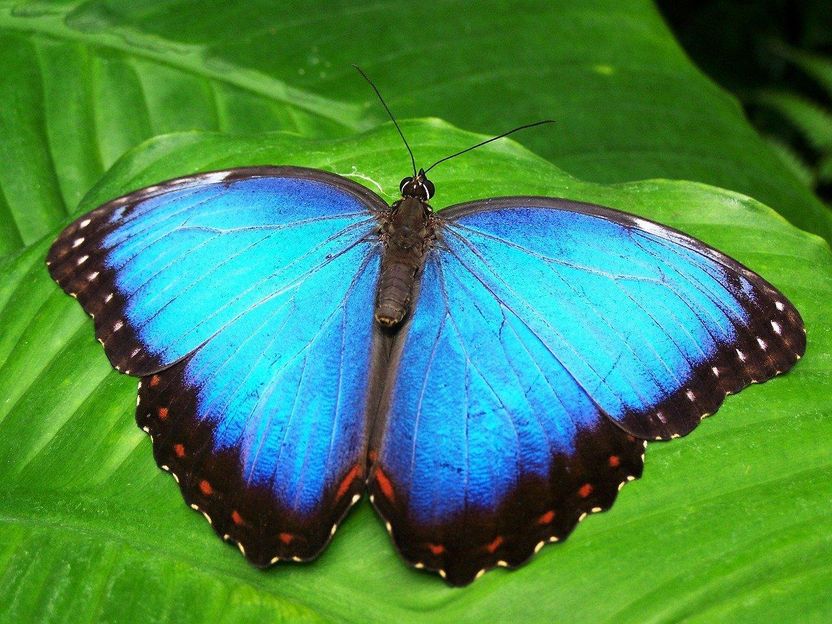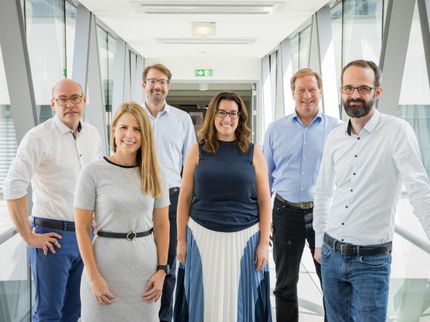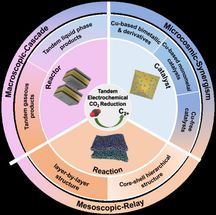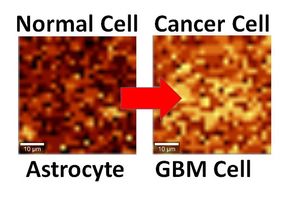3D printed surfaces inspired by nature
Biologically inspired structural colours for anti-counterfeiting applications
Scientists can use laser radiation to print tiny structures with high precision. This approach enables them to mimic the superpowers of animals and plants and makes them accessible for engineering applications.

The structure of the surface of its wings gives the morpho butterfly its blue colour.
pixabay.com
To survive in extreme habitats, many animals and plants have developed brilliant abilities that we otherwise only know from superheroes in movies. In most cases, their abilities are based on the extraordinary properties of their surfaces. Mimicking these properties offers enormous potential in the engineering field for developing new products and solving technical problems. Research teams from Bochum and Kiel have succeeded in mimicking the structural colour of the famous blue Morpho butterflies using a high-precision 3D printing technology referred to as two-photon polymerization (2PP). The researchers present their newest findings in a paper published in the Journal of Optical Microsystems on 2 September 2022.
The study in the field of biomimetics was conducted by researchers from the Applied Laser Technologies at Ruhr-Universität Bochum (RUB), headed by Professor Andreas Ostendorf and Professor Cemal Esen, and from the “Functional Morphology and Biomechanics” group at Kiel University (CAU), headed by Professor Stanislav Gorb.
3D printing of biologically inspired Christmas trees
2PP is a laser-based printing technology that allows the processing of photosensitive resins in all three dimensions. Unlike conventional printing techniques, it is, thus, possible to create complex and true 3D structures using virtual computer models without the need for support structures. In addition, 2PP enables high-resolution since single structural features can measure a size down to 100 nanometres. This number corresponds roughly to one-thousandth of the thickness of human hair.
The 3D printing capabilities of 2PP enabled the researchers to produce hierarchically composed structures at the micro- and nanometre scale. In this way, they were able to mimic the structural colour of the blue Morpho butterflies, including their extraordinary optical properties. The colour of the butterflies is formed by tiny Christmas tree-like structures on their upper wing surface. Moreover, complex physical phenomena between light and the Christmas trees make it possible to observe the blue colour as almost angle-insensitive. “This is very surprising because normally structural colour appears iridescent like a rainbow when it is generated by similar physical phenomena, such as refraction, for example,” says RUB researcher Gordon Zyla.
Biologically inspired structural colours for anti-counterfeiting applications
In their current work, published in the Journal of Optical Microsystems, the researchers present a successful redesign of their butterfly-inspired structures from previous publications. The redesigns enabled them to observe the resulting angle-insensitive blue colour uniformly or only from specific directions. For this purpose, they first analysed the optical properties and morphology of the wing surface of a Morpho didius butterfly at CAU. Based on their findings, they derived that they can control the direction in which the angle-insensitive colour appears by changing the geometry of their hierarchically composed structures only on the microscale while still mimicking the butterfly’s structures on the nanoscale.
The novel designs proposed by the authors are suitable, for example, for manufacturing highly complex anti-counterfeiting features. Overall, their research demonstrates the great potential of the 2PP technology for its use in biomimetics. In this context, the authors assume that a wide variety of functional structures from nature could be mimicked using 2PP in combination with novel photosensitive materials. Thus, other superpowers found in organisms could also be made accessible for different engineering applications. These are, for example, improved adhesion and wear resistance to various surfaces, superhydrophobicity, commonly referred to as the lotus effect, or other colorations used in nature as warning signals, camouflage, or intrasexual communication.
Original publication
Most read news
Other news from the department science

Get the chemical industry in your inbox
By submitting this form you agree that LUMITOS AG will send you the newsletter(s) selected above by email. Your data will not be passed on to third parties. Your data will be stored and processed in accordance with our data protection regulations. LUMITOS may contact you by email for the purpose of advertising or market and opinion surveys. You can revoke your consent at any time without giving reasons to LUMITOS AG, Ernst-Augustin-Str. 2, 12489 Berlin, Germany or by e-mail at revoke@lumitos.com with effect for the future. In addition, each email contains a link to unsubscribe from the corresponding newsletter.
Most read news
More news from our other portals
Last viewed contents

Chimicom S.R.L. - Ovada, Italy
List_of_drugs:_P-Pa
Celanese and Blackstone to Form Joint Venture in Acetate Tow


























































